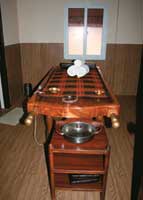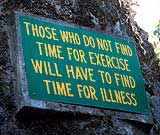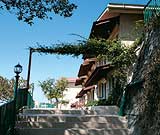|
“I sit down to write an article about Ayurveda and Avalon, a likely couple...
For just as the word ‘Avalon’ conjours up an image of mysterious ancient times and pure hearted folk, a sword that rises out of the water and a sword whose blade is fixed in stone - the one same sword at that, so do the words ‘Veda’ and ‘Ayur’ translate as ‘Way of’ and ‘Life’ in just one word,
‘Ayurveda’.
A ‘Way of Life’ that causes the reality of existence to be
realised.
Here in this context, Avalon is the ‘Way of’ and Ayurveda is ‘Life’ as the Avalon resort provides a perfect place for this ancient knowledge of India to be
practised.
 Positioned high upon the actual ridge top of the hill station Mussorie - commonly known as ‘Queen of the Hills’, the location has views of both valleys to the South and North sides. To the South lies a protected forest below which the city of Dehra Dun, famous for its schools and military institutions fans out, whereas to the North lies a vast stretch of the range of Himalayan mountains whose foothills undulate upwards to a fleet of snow peaks that may be easily identified. Positioned high upon the actual ridge top of the hill station Mussorie - commonly known as ‘Queen of the Hills’, the location has views of both valleys to the South and North sides. To the South lies a protected forest below which the city of Dehra Dun, famous for its schools and military institutions fans out, whereas to the North lies a vast stretch of the range of Himalayan mountains whose foothills undulate upwards to a fleet of snow peaks that may be easily identified.
It is an expansive scene, where surrounded by space one feels like one has reached the heavens. Where better to meditate upon one’s truly natural existence through the spectacles of Ayurvedic knowledge and to receive curative treatment for any ailment that may be controlling or overtaking one’s life.
For Ayurveda does not just profess a philosophy, but is a living art that may be applied to all aspects of life. If you are healthy, it demonstrates how to maintain that health and even increase vitality so that one may be able to fully realise one’s life’s ultimate potential and if you are already sick, it holds methods of treatment for every disease in the book. For health is just a natural state of being, whereas disease is but an imbalance of that natural state, nothing to fear, just something which needs to be restored to balance once again.
In order to understand what an Ayurvedic treatment entailed, I consulted a doctor at the centre located inside the Avalon resort. First he had me lie down on the consultation deck, whereby he took reading of my pulse, heart rate and blood pressure as well as prodding around my stomach area for any obvious abnormalities.
Having okayed me all round, he asked about my well-being, dietary habits, aches and pains that occur frequently along with other questions about my general state of being.
 As I was not coming for any particular cure, I was taken to the therapy room for a ‘relaxing massage’, to be performed by a lady from Kerala, South India, where this art of Ayurveda is still practised in its most authentic way and the fashion in which the treatment centre at Avalon mirrors. Surprisingly, since Ayurveda initially came from the Himalayan mountains, its present core root in Kerala is unmistakably a leap of place across time. Avalon in this sense brings back an authentic lineage to its birthplace. As I was not coming for any particular cure, I was taken to the therapy room for a ‘relaxing massage’, to be performed by a lady from Kerala, South India, where this art of Ayurveda is still practised in its most authentic way and the fashion in which the treatment centre at Avalon mirrors. Surprisingly, since Ayurveda initially came from the Himalayan mountains, its present core root in Kerala is unmistakably a leap of place across time. Avalon in this sense brings back an authentic lineage to its birthplace.
Stripped naked with just a small loincloth, the therapist first massaged my head and hair. I was then ushered to the wooden table made of Neem wood, which had been deliciously heated for the session. Lying face down on its surface a flow of hot oil was poured on my back and then rubbed in, in a rhythmical way that followed various energy currents running along my body. Then legs, feet, arms, hands and face were addressed, leaving me totally wet with oil from top to toe. I have never felt such thick oil on my skin as this, like a protective cover seeping into my very being.
Then for a steam bath, the type of which I had never seen as such, where I had to sit on a chair inside a kind of tent like bag, which is heated with steam from a boiler to the side, filled with herbal extracts. Zipped up to the neck, I felt slightly light-headed with the heat as I had not eaten that morning since the treatment is said to be more effective on an empty stomach. Oil literally dripping from every part of my body, the next leg of the journey was into the shower to wash off the oil with a green coloured substance made of Mung Dahl.
And afterwards, nothing….
 They brought me a delicious herbal tea along with a book to write down my impressions and I struggled with expression as I was just simply resting in being where I was at that moment without trying to define it, the great habit of mind that continuously needs to identify itself with its environment through self-placement within it. They brought me a delicious herbal tea along with a book to write down my impressions and I struggled with expression as I was just simply resting in being where I was at that moment without trying to define it, the great habit of mind that continuously needs to identify itself with its environment through self-placement within it.
So, instead I began to scribble…
…first a teddy bear that develops into a flower; then the moon and space, an eclipse and an arrow that sinks deep into the eye; an ear to listen with and a beak to speak from, a road to carry or hold an instrument that may carry my weightless weight. Only when I become a creature of the air does
curiosity make me peer over the wall of limitation and stoop to observe its rights over me…
Have I gone mad? I observe my state.
For whilst communicating that spiel, all the way through I have no choice but to refer to ‘I’, ‘my’ and ‘me’ to give the concept meaning just as I have to relate to that ‘I’, ‘my’ and ‘me’ as a way of discovering what I am drawing. As long as I am aware of that use of ‘I’, then it will not harm any aspect of my being, but may be used as a tool to move throughout the vast space of existence.
So in Ayurveda do relative aspects of existence perceive themselves from their relative positioning.
The strongest of all is the ‘I’ factor’, that if lost in its own belief of being separate from the whole may be translated as “ego” that clings to itself as one precise and individual thing, rather than an evolved manifesting form that has transpired through a whole series of patterns, still evolving within the bigger picture.
“Cling”, (a natural thing to do with mind), I now perceive just one whole shape, having forgotten its make-up of so many shapes, lost as they are now within the idea of it having one definite meaning that may be labelled with a certain name suggesting relevant characteristics.
Not even an infinite whole, but just a boundaried shape upon a piece of paper where the infinite would only appear if I were to rub it out, leaving an entire space of potential to appear in its place.
Ayurveda has many technical Sanskrit terms, but I would not dare to profess such symbols of meaning as I am illiterate to their scholastic relevance. So, I would prefer just to leave you with this analogy of the duck who lost her teddy bear, who started out as an infinite whole without any particularisation, manifesting as many shapes that each evolve from one into another shape in turn, resulting in one defined form that may be grasped as having a certain name and
meaning.
|